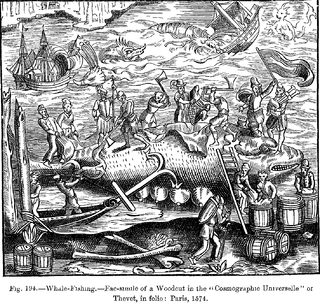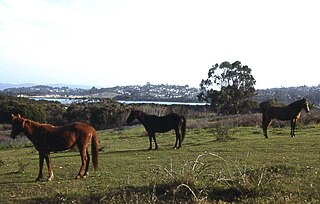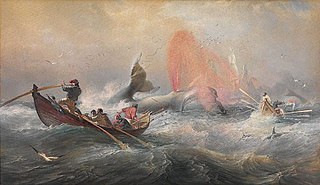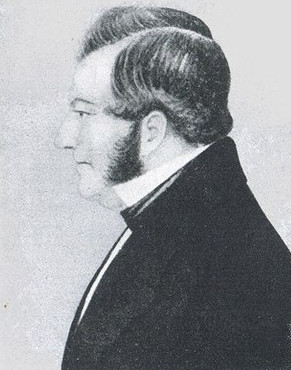
Whale watching is the practice of observing whales and dolphins (cetaceans) in their natural habitat. Whale watching is mostly a recreational activity, but it can also serve scientific and/or educational purposes. A study prepared for International Fund for Animal Welfare in 2009 estimated that 13 million people went whale watching globally in 2008. Whale watching generates $2.1 billion per annum in tourism revenue worldwide, employing around 13,000 workers. The size and rapid growth of the industry has led to complex and continuing debates with the whaling industry about the best use of whales as a natural resource.

This article discusses the history of whaling from prehistoric times up to the commencement of the International Whaling Commission (IWC) moratorium on commercial whaling in 1986. Whaling has been an important subsistence and economic activity in multiple regions throughout human history. Commercial whaling dramatically reduced in importance during the 19th century due to the development of alternatives to whale oil for lighting, and the collapse in whale populations. Nevertheless, some nations continue to hunt whales even today.

King George Sound is a sound on the south coast of Western Australia. Named King George the Third's Sound in 1791, it was referred to as King George's Sound from 1805. The name "King George Sound" gradually came into use from about 1934, prompted by new Admiralty charts supporting the intention to eliminate the possessive 's' from geographical names.

Eden is a coastal town in the South Coast region of New South Wales, Australia. The town is 478 kilometres (297 mi) south of the state capital Sydney and is the most southerly town in New South Wales, located between Nullica Bay to the south and Calle Calle Bay, the northern reach of Twofold Bay, and built on undulating land adjacent to the third-deepest natural harbour in the southern hemisphere, and Snug Cove on its western boundary. At the 2016 census, Eden had a population of 3,151.

Flensing is the removing of the blubber or outer integument of whales, separating it from the animal's meat. Processing the blubber into whale oil was the key step that transformed a whale carcass into a stable, transportable commodity. It was an important part of the history of whaling. The whaling that still continues in the 21st century is both industrial and aboriginal. In aboriginal whaling the blubber is rarely rendered into oil, although it may be eaten as muktuk.

Whaling in Australian waters began in 1791 when five of the 11 ships in the Third Fleet landed their passengers and freight at Sydney Cove and then left Port Jackson to engage in whaling and seal hunting off the coast of Australia and New Zealand. The two main species hunted by such vessels in the early years were right and sperm whales. Humpback, bowhead and other whale species would later be taken.
Over 1400 ships have been wrecked on the coast of Western Australia. This relatively large number of shipwrecks is due to a number of factors, including:

Henry Robertson was a Scottish-born Australian seaman, engineer, folk-singer/songwriter, poet and activist, who became a key figure in the development of the Australian folk music tradition. During the 1950s he served in commercial whaling fleets in both sub-antarctic and sub-tropical regions, and wrote a number of songs about his experiences which formed the basis of his 1971 LP release Whale Chasing Men: Songs of Whaling in Ice and Sun, a unique record of life in the whaling industry in the 20th century. He also composed and performed songs on a range of other subjects, including compositions for historical documentaries commissioned by Australian television, a number of which have since been recorded posthumously by musicians interested in perpetuating his musical legacy.
Thistle Island / Noondala is in the Spencer Gulf, South Australia, some 200 kilometres (120 mi) west of Adelaide, and northwest of the Gambier Islands. The city of Port Lincoln lies to the northwest of the island. Between them, the Gambier Islands and Thistle form a chain across the mouth of the gulf between the southern tips of the Yorke and Eyre Peninsulas, sometimes referred to as the Taylor Islands group.

Commercial whaling in New Zealand waters began late in the 18th century and continued until 1965. It was a major economic activity for Europeans in New Zealand in the first four decades of the 19th century. Nineteenth-century whaling was based on hunting the southern right whale and the sperm whale and 20th-century whaling concentrated on the humpback whale.

Bathers Beach, also known as Whalers Beach, is a section of coastline that has a written history since the European settlement of what is now called Fremantle, Western Australia.

Daniel Scott was a Western Australian harbour-master. Originally from Liverpool, England, he moved to the newly established Swan River Colony in 1829. Scott was the first chair of the Fremantle Town Trust in 1848. In addition to his civic and harbour duties, he was involved with launching a number of enterprises in early Western Australia, including the first whaling business, the first ship builders, and a lead mining business.

Cheyne Beach Whaling Station is a defunct whaling station in Australia. It now operates as a tourist park known as Albany's Historic Whaling Station, and has previously also been known as Whaleworld or Whale World. The station is situated in Frenchman Bay in King George Sound and was built in the 1950s, operating until 1978.

Doubtful Islands are a group of three small islands located approximately 3 kilometres (2 mi) offshore of Point Hood and approximately 20 kilometres (12 mi) east of Bremer Bay in Western Australia.
Fanny Nicholson was an iron-framed, timber-clad barque that sank in 1872 in Frenchman's Bay in King George Sound near Albany in the Great Southern region of Western Australia.

Commercial whaling in Britain began late in the 16th century and continued after the 1801 formation of the United Kingdom and intermittently until the middle of the 20th century.

A drift whale is a cetacean mammal that has died at sea and floated into shore. This is in contrast to a beached or stranded whale, which reaches land alive and may die there or regain safety in the ocean. Most cetaceans that die, from natural causes or predators, do not wind up on land; most die far offshore and sink deep to become novel ecological zones known as whale falls. Some species that wash ashore are scientifically dolphins, i.e. members of the family Delphinidae, but for ease of use, this article treats them all as "drift whales". For example, one species notorious for mass strandings is the pilot whale, also known as "blackfish", which is taxonomically a dolphin.

Davidson Whaling Station is a heritage-listed former whaling station at Edrom, Bega Valley Shire, New South Wales, Australia. It was built in 1896. The property is owned by the New South Wales Office of Environment and Heritage. It was added to the New South Wales State Heritage Register on 2 April 1999.
Lord Hawkesbury was launched in the United States in 1781, probably under another name. She entered Lloyd's Register in 1787. She made six voyages as a whaler. On her second whaling voyage she "the first parcel of ambergris 'by any English whaler'". She was lost on the seventh after a squadron of French naval vessels had captured her. One of her original, British crew succeeded in regaining sufficient control from her prize crew to enable him to run her aground, wrecking her.

Russian whaling has been conducted by native peoples in the Chukotka region of Russia since at least 4,000 years ago by native Yupik and Chukchi people, but commercial whaling did not begin until the mid-19th century, when companies based in Finland sent out vessels to the Pacific. It was not until 1932 that modern pelagic whaling began to take off with the purchase of an American cargo ship which was renamed the Aleut, which was the only Soviet factory ship until World War II. After the war, with the need for a stronger Soviet economy and rapid industrialization of the country during the 1940s and 1950s, Soviet whaling took off and became a truly global industry. The first Soviet whalers reached the Antarctic during the 1946–47 season with the factory ship Slava and then underwent a rapid expansion during the late 1950s in which 5 new fleets were added within a 4-year span: Sovetskaya Ukraina in 1959, Yuriy Dolgorukiy in 1960, and Sovetskaya Rossiya in 1961 for the Antarctic, and finally two large fleets in 1963 for the North Pacific. Thus, by the early 1960s Soviet whaling had truly become a global industry, operating in every ocean except the North Atlantic and undertaking voyages that could last as long as seven months each. From 1964 to 1973, the Soviet Union was considered by some the biggest whaling nation in the world.

















